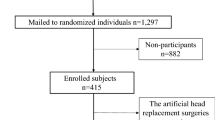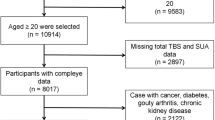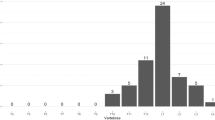Abstract
Objective: To examine changes in radial bone density and biochemical status, with particular reference to calcium, over 18 months in a group of older men.
Subjects: Thirty-six healthy men (aged 66–76 y) were recruited to the study during July and August, 1993. These men were free-living residents of Edmonton who were recruited through local organizations for the retired and semi-retired. Data for the younger group of men (age 29–60 y) were taken from a previous study conducted in our laboratory.
Design: Using special-purpose computed tomography (γCT), trabecular (TBD), cortical (CBD) and integral (IBD) bone densities (gm/cm3) were measured in the ultra-distal radius at 6-month intervals over 18 months. At baseline, and at each subsequent study visit, serum was obtained from each subject for determinations of calcium, phosphate, 25-hydroxyvitamin D, alkaline phosphatase, and immunoreactive parathyroid hormone. A 24-h urine sample was also obtained at each study visit for determination of urinary calcium, phosphate and creatinine.
Results: In repeated measures analysis of variance of the data for the older men serum 25-hydroxyvitamin D was significantly decreased (P<0.001) over time, while TBD was increased (+0.60% per year, P<0.01). Longitudinal rates of change for TBD, CBD and IBD were: −0.94%, 0.92% and 0.74% per year respectively when bone density data at baseline for the older men and the historical data for younger men were combined. However, separate analyses of the data for the younger and the older men indicated no significant age-related changes in bone density for men aged 29–60 y, or for men aged 66–76 y. However, differences in TBD, CBD and IBD between the younger and older groups of men were significant (P<0.001).
Conclusions: In a group (n=36) of older men (mean age 71.7 y) studied longitudinally over 18 months, bone density in the distal radius did not decrease over time. Mean bone density in this group of men was, however, significantly (P<0.001) lower than in a group of younger men (n=17, mean age 46.7 y). Regression analysis using cross-sectional bone density data at baseline for the older male group, and historical data for the younger male group, indicates that bone loss occurs with increasing age at a rate of about 1% per year averaged over ages 29–76 y. Bone density variables were not correlated with either height or weight, or with any biochemical or hormonal variable measured in this study.
Sponsor: The work was funded in part by the Dairy Bureau of Canada.
This is a preview of subscription content, access via your institution
Access options
Subscribe to this journal
Receive 12 print issues and online access
$259.00 per year
only $21.58 per issue
Buy this article
- Purchase on Springer Link
- Instant access to full article PDF
Prices may be subject to local taxes which are calculated during checkout
Similar content being viewed by others
Author information
Authors and Affiliations
Rights and permissions
About this article
Cite this article
Overton, T., Basu, T. Longitudinal changes in radial bone density in older men. Eur J Clin Nutr 53, 211–215 (1999). https://doi.org/10.1038/sj.ejcn.1600703
Received:
Revised:
Accepted:
Published:
Issue Date:
DOI: https://doi.org/10.1038/sj.ejcn.1600703
Keywords
This article is cited by
-
Usability of cooperative surgical telemanipulation for bone milling tasks
International Journal of Computer Assisted Radiology and Surgery (2021)



